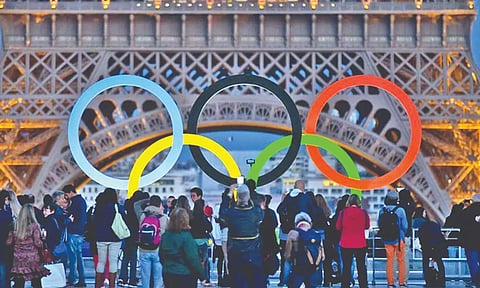

By Olivia Gerstenberger
PARIS: The expectations for Paris are high — in every respect,” said International Olympic Com- mittee President Thomas Bach last summer, a year before the start of the Paris Olympics. The idea is to make the 2024 Summer Olympics sustainable and inclusive, with gender equality being a top priority.
Organisers are also aiming to make the host city an integral part of the Games. The opening ceremony won’t be in the Olympic Stadium, but rather on the Seine with more than 400,000 people lining the banks of the river. The Paris 2024 organisers are planning to reduce CO2 emissions by around half to about1.58 million tons, compared to 3.4 million released at the 2012 London Summer Games, and 3.6 million in Rio de Janeiro four years later.
A major part of the strategy is to keep travel to a minimum. Almost all of the Olympic venues are located within a radius of just 10 kilometers (6 miles) — though the surfing competition will be held more than 15,000 km away, on the South Pacific island of Tahiti. The venue planning means most athletes should be able to reach their venues within just 30 minutes. Ninety-five percent of the venues, such as the Parc des Princes or Roland Garros, already existed long before the decision to host was taken. Organisers are focusing on use of renewable energy as well as sustainable catering and recycling.
Emissions that cannot be reduced or prevented are to be offset by environmentally friendly projects such as reforestation. Organisers aim to support local projects to combat climate change particularly in Paris and the Ile-de-France region around the French capital. One facet is the “Climate Coach” app, which is designed to help people reduce their personal and professional carbon footprints. One important step is the extensive cleansing of the Seine, where the open water swimming and triathlon competitions are to take place. The idea is that after the Games are over, both locals and tourists will be able to swim in the city’s famous river.
Most of the energy for the Games is to come from renewable sources like wind and solar power, and organisers are promoting environmentally friendly means of transport to the venues such as the subway and bicycles. They have also made a point of refraining from constructing any new parking facilities near the sports venues.
During the Games, the focus will be on sustainable, low-meat catering featuring local and seasonal products as a way to minimise waste and food waste. During the Games, the amount of single-use plastic is to be halved through reusable drinking bottles and drinking fountains.
The construction of the Olympic Village in the Seine-Saint-Denis department generated 47% fewer CO2 emissions than conventional methods. “We used a lot of wood, low-carbon concrete [and] used ships for transportation, which has saved us 25,000 truck journeys, and we have installed a heating and cooling system based on geothermal energy,” Marion Le Paul, deputy director general of Solideo, the public body in charge of Olympic infrastructure, told DW.
The athletes’ village will also be without air conditioning.
A year before the start of the Games, Paris began converting parking spots in the city into green spaces, building new cycle paths and anti-noise walls and renovating buildings to make them more climate-friendly. There are also plans to lower the speed limits on Paris’ highways and ban buses from the city center.